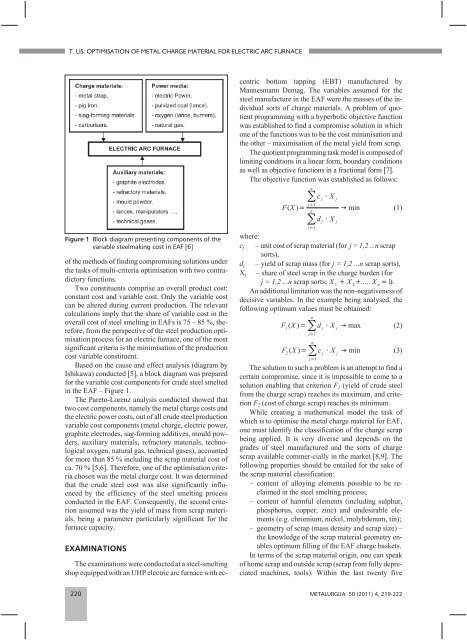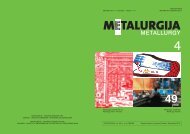PDF - 2453 kB - CARNet
PDF - 2453 kB - CARNet
PDF - 2453 kB - CARNet
You also want an ePaper? Increase the reach of your titles
YUMPU automatically turns print PDFs into web optimized ePapers that Google loves.
T. LIS: OPTIMISATION OF METAL CHARGE MATERIAL FOR ELECTRIC ARC FURNACE<br />
Figure 1 Block diagram presenting components of the<br />
variable steelmaking cost in EAF �6�<br />
of the methods of finding compromising solutions under<br />
the tasks of multi-criteria optimisation with two contradictory<br />
functions.<br />
Two constituents comprise an overall product cost:<br />
constant cost and variable cost. Only the variable cost<br />
can be altered during current production. The relevant<br />
calculations imply that the share of variable cost in the<br />
overall cost of steel smelting in EAFs is 75 – 85 %, therefore,<br />
from the perspective of the steel production optimisation<br />
process for an electric furnace, one of the most<br />
significant criteria is the minimisation of the production<br />
cost variable constituent.<br />
Based on the cause and effect analysis (diagram by<br />
Ishikawa) conducted �5�, a block diagram was prepared<br />
for the variable cost components for crude steel smelted<br />
in the EAF – Figure 1.<br />
The Pareto-Lorenz analysis conducted showed that<br />
two cost components, namely the metal charge costs and<br />
the electric power costs, out of all crude steel production<br />
variable cost components (metal charge, electric power,<br />
graphite electrodes, sag-forming additives, mould powders,<br />
auxiliary materials, refractory materials, technological<br />
oxygen, natural gas, technical gases), accounted<br />
for more than 85 % including the scrap material cost of<br />
ca. 70 % �5,6�. Therefore, one of the optimisation criteria<br />
chosen was the metal charge cost. It was determined<br />
that the crude steel cost was also significantly influenced<br />
by the efficiency of the steel smelting process<br />
conducted in the EAF. Consequently, the second criterion<br />
assumed was the yield of mass from scrap materials,<br />
being a parameter particularly significant for the<br />
furnace capacity.<br />
EXAMINATIONS<br />
The examinations were conducted at a steel-smelting<br />
shop equipped with an UHP electric arc furnace with ec-<br />
centric bottom tapping (EBT) manufactured by<br />
Mannesmann Demag. The variables assumed for the<br />
steel manufacture in the EAF were the masses of the individual<br />
sorts of charge materials. A problem of quotient<br />
programming with a hyperbolic objective function<br />
was established to find a compromise solution in which<br />
one of the functions was to be the cost minimisation and<br />
the other – maximisation of the metal yield from scrap.<br />
The quotient programming task model is composed of<br />
limiting conditions in a linear form, boundary conditions<br />
as well as objective functions in a fractional form �7�.<br />
The objective function was established as follows:<br />
n<br />
�<br />
cj � X j<br />
j�1<br />
FX ( ) � � min<br />
n<br />
�<br />
j�1<br />
d � X<br />
j j<br />
(1)<br />
where:<br />
cj – unit cost of scrap material (for j = 1,2 ...n scrap<br />
sorts),<br />
dj – yield of scrap mass (for j = 1,2 ...n scrap sorts),<br />
Xj – share of steel scrap in the charge burden (for<br />
j = 1,2 ...n scrap sorts; X1 �X2�..... Xn�1). An additional limitation was the non-negativeness of<br />
decisive variables. In the example being analysed, the<br />
following optimum values must be obtained:<br />
n<br />
F1( X) �� dj �X j �max<br />
(2)<br />
j�1<br />
n<br />
F2( X) �� cj �X j �min<br />
(3)<br />
j�1<br />
The solution to such a problem is an attempt to find a<br />
certain compromise, since it is impossible to come to a<br />
solution enabling that criterion F1 (yield of crude steel<br />
from the charge scrap) reaches its maximum, and criterion<br />
F2 (cost of charge scrap) reaches its minimum.<br />
While creating a mathematical model the task of<br />
which is to optimise the metal charge material for EAF,<br />
one must identify the classification of the charge scrap<br />
being applied. It is very diverse and depends on the<br />
grades of steel manufactured and the sorts of charge<br />
scrap available commer-cially in the market �8,9�. The<br />
following properties should be entailed for the sake of<br />
the scrap material classification:<br />
– content of alloying elements possible to be reclaimed<br />
in the steel smelting process;<br />
– content of harmful elements (including sulphur,<br />
phosphorus, copper, zinc) and undesirable elements<br />
(e.g. chromium, nickel, molybdenum, tin);<br />
– geometry of scrap (mass density and scrap size) –<br />
the knowledge of the scrap material geometry enables<br />
optimum filling of the EAF charge baskets.<br />
In terms of the scrap material origin, one can speak<br />
of home scrap and outside scrap (scrap from fully depreciated<br />
machines, tools). Within the last twenty five<br />
220 METALURGIJA 50 (2011) 4, 219-222

















